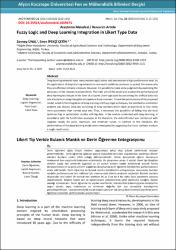| dc.contributor.author | Ünal, Zeynep | |
| dc.contributor.author | İpekçi Çetin, Emre | |
| dc.date.accessioned | 2023-09-19T08:01:35Z | |
| dc.date.available | 2023-09-19T08:01:35Z | |
| dc.date.issued | 28.02.2022 | en_US |
| dc.identifier.citation | Ünal, Z. & İpekçi Çetin, E. (2022). Fuzzy Logic and Deep Learning Integration in Likert Type Data . Afyon Kocatepe Üniversitesi Fen Ve Mühendislik Bilimleri Dergisi , 22 (1) , 112-125 . DOI: 10.35414/akufemubid.1019671 | en_US |
| dc.identifier.uri | https://dergipark.org.tr/tr/download/article-file/2065862 | |
| dc.identifier.uri | https://doi.org/10.35414/akufemubid.1019671 | |
| dc.identifier.uri | https://hdl.handle.net/11630/11087 | |
| dc.description.abstract | Deep learning networks have many modern applications and demonstrate a high-performance level. As the applications of deep learning networks to real-world problems continues to spread, the reason why they are effective remains unknown. However, it is possible to make some judgments by examining the behaviour of the network in experiments. The main aim of this study is to analyse the performance of deep learning techniques in the form of a 5-point Likert-type scale by converting the artificial data sets into a fuzzy form using triangular or trapezium fuzzy numbers. To test the performance of the proposed model, which is the integration of deep learning and fuzzy logic techniques, the satisfaction estimation problem was chosen. Data sets consisting of fuzzy numbers which reach at least three or four times more parameters than normal data sets. Thus, it decreases the possibility of falling into the local optimum trap in optimization studies with big data. In the analysis conducted with deep learning, in accordance with the fuzzification examples in the literature, the defuzzification was carried out with separate results for peak, maximum, and minimum values. In contrast to the literature, the performances of the deep learning model were investigated by suggesting that fuzzy numbers produce a single result series. | en_US |
| dc.description.abstract | Derin öğrenme ağları birçok modern uygulamaya sahip olup yüksek performans seviyesi
göstermektedir. Derin öğrenme ağlarının gerçek dünyadaki sorunlara uygulamaları yayılmaya devam
ederken bunların neden etkili olduğu bilinmemektedir. Ancak deneylerde ağların davranışını
inceleyerek bazı yargılarda bulunmak mümkündür. Bu çalışmanın amacı 5 noktalı Likert tipi ölçeğiyle
üretilen yapay veri setlerinin üçgensel ya da yamuk bulanık sayılar kullanılarak bulanık forma
dönüştürülmesi ve bu yolla verilerin çoğalması durumunda derin öğrenme tekniklerinin performansının
analiz edilmesidir. Derin öğrenme ve bulanık mantık tekniklerinin entegrasyonu sonucunda önerilen
modelin performansının test edilmesi için memnuniyet tahmin problemi seçilmiştir Bulanık sayılarla
oluşturulan veri setleri ile normal veri setinden en az 3 ya da 4 kat daha fazla parametre sayısına
ulaşılmaktadır. Böylece büyük veri ile optimizasyon çalışmalarında yerel optimuma tuzağına düşme
olasılığı azalmaktadır. Derin öğrenme ile yapılan analizlerde, literatürdeki bulanıklaştırma örneklerine
uygun olarak, tepe, maksimum ve minimum değerler için ayrı sonuçlarla durulaştırma
gerçekleştirilmiştir. Literatürden farklı olarak bulanık sayıların tek sonuç dizisi üretmesi önerilerek derin
öğrenme modelinin performansları araştırılmıştır. | en_US |
| dc.language.iso | eng | en_US |
| dc.publisher | Afyon Kocatepe Üniversitesi | en_US |
| dc.identifier.doi | 10.35414/akufemubid.1019671 | en_US |
| dc.rights | info:eu-repo/semantics/openAccess | en_US |
| dc.subject | Deep Learning | en_US |
| dc.subject | Logistic Regression | en_US |
| dc.subject | Fuzzy Logic | en_US |
| dc.subject | Likert Scale | en_US |
| dc.subject | Derin Öğrenme | en_US |
| dc.subject | Lojistik Regresyon | en_US |
| dc.subject | Bulanık Mantık | en_US |
| dc.subject | Likert Ölçeği | en_US |
| dc.title | Fuzzy logic and deep learning ıntegration in likert type data | en_US |
| dc.title.alternative | Likert tip veride bulanık mantık ve derin öğrenme entegrasyonu | en_US |
| dc.type | article | en_US |
| dc.relation.journal | Afyon Kocatepe Üniversitesi Fen ve Mühendislik Bilimleri Dergisi | en_US |
| dc.department | Afyon Kocatepe Üniversitesi | en_US |
| dc.authorid | 0000-0002-9954-1151 | en_US |
| dc.authorid | 0000-0002-8108-1919 | en_US |
| dc.identifier.volume | 22 | en_US |
| dc.identifier.startpage | 112 | en_US |
| dc.identifier.endpage | 125 | en_US |
| dc.identifier.issue | 1 | en_US |
| dc.relation.publicationcategory | Makale - Ulusal Hakemli Dergi - Başka Kurum Yazarı | en_US |



















